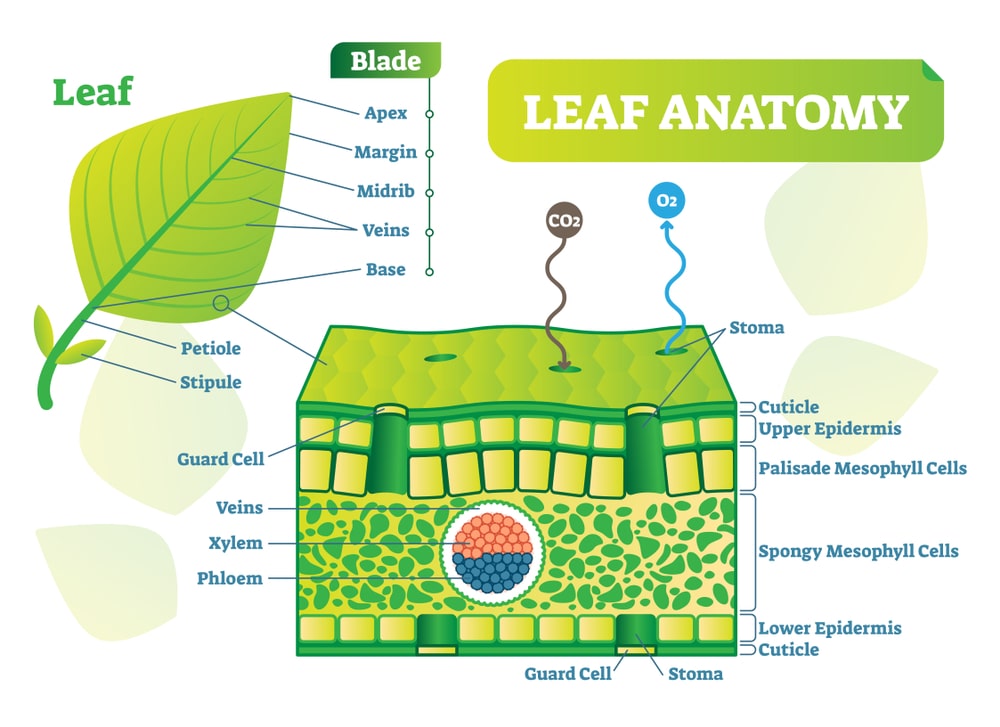Morphology of Leaves: Leaves are flat, thin green, appendages to the stem, containing supporting and conducting strands in their structure. They develop in such a way that older leaves are placed at the base while the younger ones at the apex.
A typical angiospermic leaf consists of the following parts
Table of Contents
(a) Leaf base or hypopodium: Using which it is attached to the stem.
(b) Petiole: It is the stalk of the leaf with which the leaf blade is attached to the stem. It is also known as mesopodium. It may be present in the leaf or may be absent in the leaf. Leaves with petiole are called petiolate, and those without petiole are sessile. They may be short or long and cylindrical. Sometimes, it is flattened as in the case of lemon. Then it is described as a winged petiole. In some plants, the petiole undergoes modification to form the tendrillar petiole which helps the plant to climb, e.g. clematis. In a few aquatic plants, it enlarges to form the swollen petiole by enclosing air and thus keeping the entire plant floating over the water. In a few other cases, the petiole enlarges to such an extent to form the leaf-like structure as in Australian acacia and is known as phyllodes.
(c) Lamina or Leaf blade: The flat expanded part of the leaf is lamina or leaf blade (Epipodium). The lamina may be thick as in xerophytic leaves or thin as in hydrophytes or intermediate as in mesophytes.
(d) Stipules: These are the two small outgrowths found at the base of the leaf, to protect the axillary bud. Leaves may or may not have stipules. Leaves with stipules are described as stipulate, while those without stipules are described as ex-stipulate.
Some stipules perform special functions and hence are put into the following types:
- Tendrillar stipules: The stipules get modified into coiled, tendrils helping the plant to climb, i.e. Indian sarsaparilla (Smilax microphylla).
- Foliaceous stipules: In the case of plants with compound leaves some of the leaflets get converted into a tendril and the stipules expand to form the flat surface and carry on photosynthesis, i.e. Lathyrus or Pisum.
- Bud stipules: Scaly stipules of the Ficus sp. are characteristic, which protect the terminal vegetative bud. With the development and unfolding of the leaf, the bud stipule falls off.
- Spiny stipules: In some plants, the stipules get converted into spines and help against browsing animals as in the case of Acacia and Zizyphus.
There are five types of stipules which are as under:
- Free lateral: These are free and located on either side of the leaf as in China rose.
- Adnate: When the stipules unite with the petioles forming wing-like structures are known as adnate stipules, i.e. Groundnut, rose, etc.
- Inter-petiolar: When stipules are located in between the two petioles of two leaves as in ixora.
- Axillary: When two stipules unite becoming axillary to the leaves.
- Ochreate stipules: These form a hollow tube around the stem as in Polygonum.
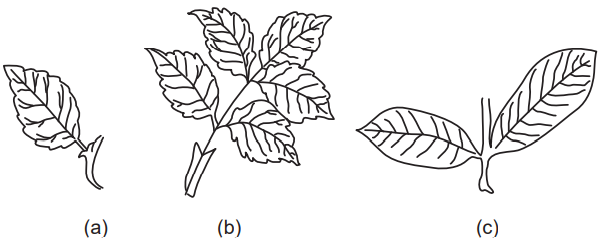
Before considering the further anatomical details of the leaves, it is very essential to know the basic difference botanically between the leaf and the leaflet which is as under:
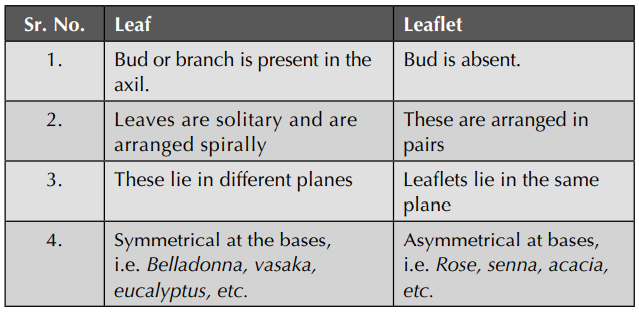
The shape of the lamina of leaves
Various shapes of the leaves are due to various types or shapes of the lamina. It may be one of the following:
- Acicular: Needlelike, i.e. pinus.
- Subulate: With acute apex and recurved point, i.e. Ephedra sinica.
- Linear: When it is long, narrow, and flat, i.e. Grasses.
- Oblong: Broad leaves with two parallel margins and abruptly tapering apex, i.e. Banana.
- Lanceolate: Which look like lance or spear-shaped, e.g. Nerium, senna.
- Ovate: Egg-shaped or broad base and narrow apex, e.g. China rose, Buchu.
- Obovate: Broad apex and narrow base, e.g. Jangalibadam.
- Obcordate: Inversely heart-shaped, i.e. base is narrow but the apex is broad, e.g. Oxalis.
- Spathulate: Like spatula or spoon-shaped as in calendula and drosera.
- Cuneate: Wedge-shaped as in pista.
- Cordate: Heart-shaped, i.e. betel.
- Sagittate: Arrow shaped such as in arum.
- Hastate: When the two lobes of a sagittate leaf are directed outwards as in ipomoea.
- Reniform: Kidney-shaped, i.e. Indian pennywort.
- Auriculate: When the leaf has got ear-like projections at the base.
- Lyrate: When it is lyre-shaped or the blade is divided into lobes with large marginal lobe, i.e. radish mustard.
- Runcinate: With the lobes convex before and straight behind, pointing backward like the teeth of the double saw, i.e. dendelion leaf.
- Rotund (Orbicular): When the blade is circular or round, e.g. lotus.
- Elliptical or oval: When the leaves are narrow at the base and apex but broad in the middle such as guava, vinca, etc.
- Peltate: When the lamina is shield-shaped and fixed to the stalk by the center.
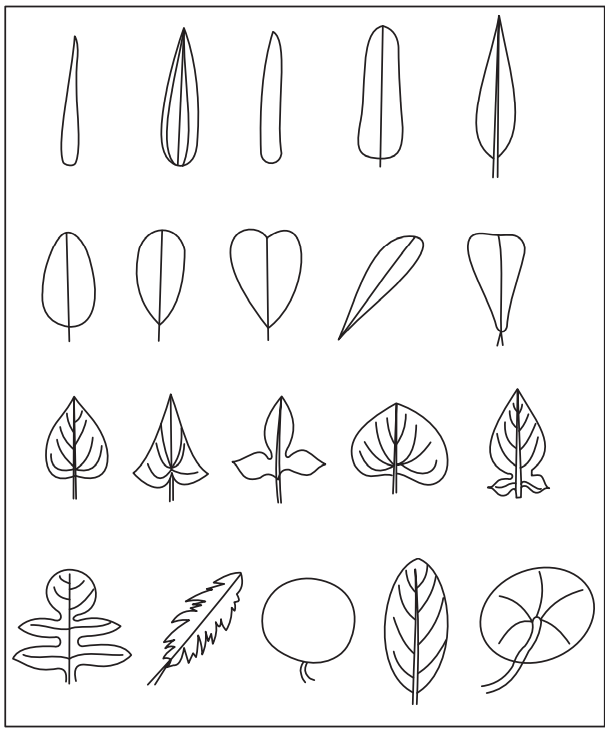
Leaf margins
Leaf margin may be of the following types:
- Entire: When it is even and smooths, i.e. senna, eucalyptus.
- Sinuate or wavy: With slight undulations like Ashok.
- Crenate: When the teeth are round as in digitalis.
- Dentate: Toothed margin, teeth directing outwards such as margosa, melon.
- Serrate: When it is like the teeth of the saw such as rose, China rose, etc.
- Ciliated: It is fringed with hairs.
- Biserrate: Lobed serrate margin.
- Bicrenate: Lobed crenate margin.

Leaf apices
The apex of the leaf may be one of the following kinds:
- Obtuse: Rounded tip, i.e. banyan.
- Acute: When it is pointed to form an acute angle, but not stiff, i.e. hibiscus.
- Acuminate: Pointed tip with much elongation, peepal.
- Recurved: When the apex is curved backward.
- Cuspidate: With a spiny tip like the date palm.
- Mucronate: Rounded apex ending abruptly in a short point i.e vinca, ixora.
- Retuse: Broad tip with a slight notch, i.e. pistia.
- Emarginate: When the tip is deeply notched as in bambinia.
- Tendrillar: Tip forming a tendril such as Gloriosa – superba.
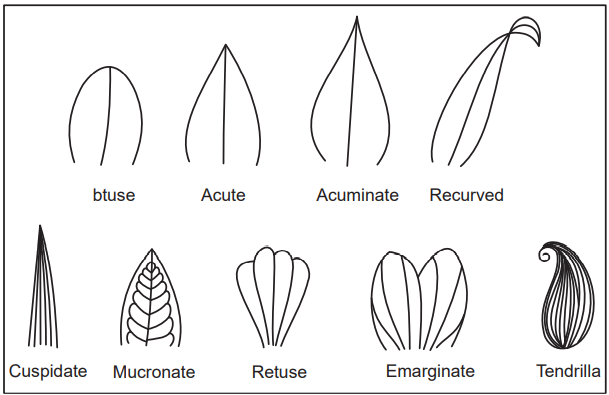
Leaf bases
The lower extremity of the lamina of the leaf may exhibit one of the following shapes:
- Symmetrical: Equal as in vasaka.
- Asymmetrical: Unequal as in senna or datura.
- Decurrent: As in digitalis.
- Cordate: As in betel.

Leaf surface
It may be of the following types:
- Glabrous: When the surface is smooth and free of hair or any outgrowth, i.e. vasaka, datura.
- Rough: When harsh to touch, digitalis.
- Hairy: When covered with hairs.
- Glutinous: When covered with a sticky substance, tobacco.
- Glaucous: When covered with a waxy coating, castor.
- Pubescent: Covered with straight, short hair, i.e. senna.
Types of leaves
Taking into consideration the nature of the lamina of the leaves, they are classified into two main groups:
- Simple leaves and
- Compound leaves.
1. Simple leaves: A leaf that has only one leaf blade or lamina is called a simple leaf. It may be stipulated or exstipulate, petiolate, or sessile, but always possess axillary bud in its axil. It may have an undivided lamina or may be lobed, e.g. vasaka, digitalis, eucalyptus, datura, Carica, castor, and argemone.
2. Compound leaves: A compound leaf consists of more than one leaf blade or the lamina, the compound leaf is divided into several segments called leaflets or pinnae, e.g. senna, tamarind, acacia.
Compound leaves have been further classified as (a) pinnate compound leaves and (b) palmate compound leaves.
(a) Pinnate compound leaves: These are sub-classified as under depending upon the number of the rachis (an axis bearing the leaflets in pinnate compound leaf is known as rachis):
- Unipinnate compound leaves: Wherein only one rachis bearing the leaflets is present. When an even number of the leaflet is present, it is known as paripinnate, e.g. tamarind, gulmohor; if the number of the leaflet is odd, it is described as imparipinnate, e.g. rose, margosa, etc.
- Bipinnate compound leaves: It consists of primary rachis and secondary rachis. The secondary rachis only bears the leaflets, e.g. acacia.
- Tripinnate compound leaves: These contain primary, secondary, and even tertiary rachis. Tertiary rachii only bear the leaflets as in moringa, oroxylon.
- Decompound leaf: Wherein compound leaf is much divided irregularly as in coriander, carrot, anise, etc.

(b) Palmate compound leaves: In this type, the leaflets are born by the petiole of the leaf.
Depending upon the number of leaflets in a compound palmate leaf they are further divided as:
- Unifoliate compound leaf: Lemon.
- Trifoliate compound leaf: Bael, wood apple.
- Multifoliate compound leaf: Bombax, Alstonia.
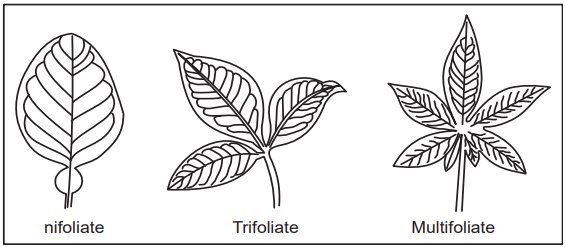
Venation
The arrangement of veins in the lamina or leaf blade is known as venation. Veins are nothing but vascular bundles. Water and minerals absorbed by roots are conveyed to various parts of the leaf by veins and the food synthesized by the leaf by way of photosynthesis is translocated to other parts of the plant through veins only. Veins also offer strength, support, and shape to the lamina of the leaf. The prominent vein in the center of the leaf is known as the midrib. In flowering plants, two types of venations exist: (1) Reticulate and (2) Parallel.
1. Reticulate venation: This type of venation is characterized by the fact that many veins and veinlets in the lamina of the leaf are arranged in the form of a network or reticulars. This type of venation is characteristic of dicotyledonous leaves. It is further sub-classified as:
- Unicostate-reticulate venation: Where the leaf contains only one midrib and several veins are given out on both sides to form the network such as henna, eucalyptus, peepal, etc.
- Multicostate-reticulate venation: In this type, many veins of equal strength arise from the end of the petiole. Each vein further branches to give rise to veinlets that form the network. The veins may be convergent (meeting at the apex) or divergent (diverge towards the margin) as in castor, Carica, and Cucurbita.
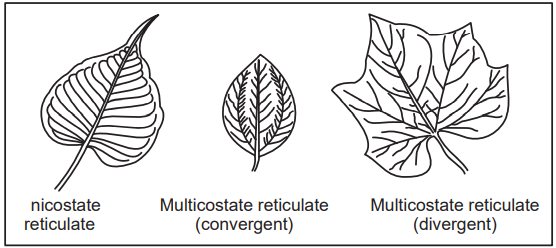
2. Parallel venation: In this type, the vein and veinlets in the leaf blade are arranged parallel to one another. It is characteristic of monocotyledonous plants with few exceptions like Dioscorea and sarsaparilla. Like reticulate venation, it may also be unicostate parallel venation or multicostate parallel venation as under:
- Unicostate parallel venation: Wherein the leaf consists of only one midrib running from the apex to the petiole of the leaf. The veinlets and veins arise parallel to one another on each side as in banana and canna.
- Multicostate parallel venation: In the case of multicostate parallel venation many main veins of equal strength arise from the tip or the petiole and run parallel to each other. It may be convergent as in the case of several grasses and bamboo or divergent as in the case of the fan palm.
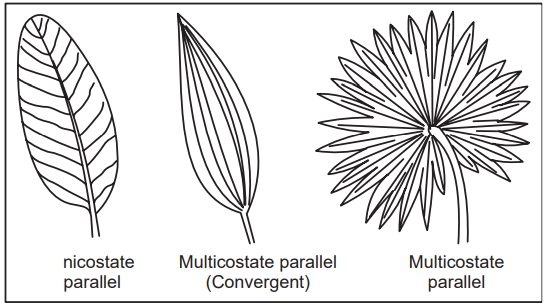
Phyllotaxy
It is the mode of arrangement of leaves on the stem. Since the leaves are the chief organs of photosynthesis they must be exposed to sunlight favorably. This is done by systematically arranging the leaves. Following are the various types of phyllotaxy:
- Alternate or spiral: This phyllotaxy is characterized by the presence of one leaf at each node and all leaves together make a spiral path on the axis, i.e. tobacco, mustard, and sunflower.
- Opposite: When two leaves are placed at the same node and are opposite to one another. This is further divided into two: (a) Opposite decussate: In this type, a pair of leaves of one node is at right angles to the pair of leaves at the next node such as madder, sacred basil, vinca. (b) Opposite superposed: When one pair of leaves is placed above the other exactly in the same plane, i.e. Rangoon creeper, ixora.
- Whorled: When more than two leaves are present in a single node and are arranged in a circle as in Nerium, Alstonia.
- Leaf mosaic: In this type, the leaves are so arranged that there will not be any overshading and all the leaves are exposed properly. The older leaves have longer petioles while younger leaves have short petioles and are placed in the space left by the older leaves. It recalls the arrangement of glass bits in a mosaic and hence the name, e.g. Oxalis and acalypha.
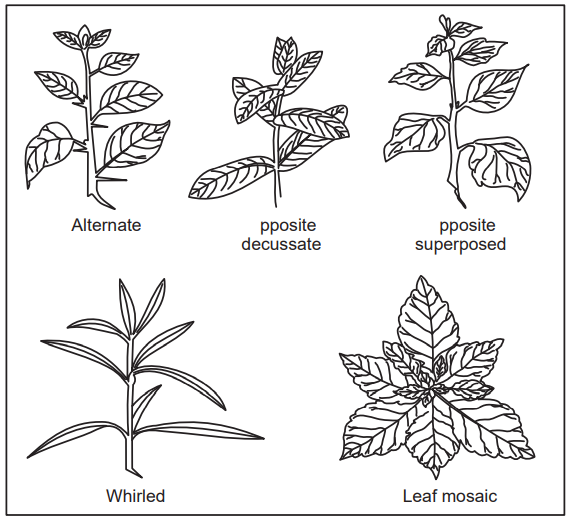
Modifications of Leaves
Under the functions of leaves, it is stated that leaves have to perform two types of functions, i.e. primary functions and secondary functions. Under the primary function, leaves are known to perform three main functions photosynthesis, gaseous exchange, and transpiration. The secondary functions which the leaf has to perform are support, protection, storage of food material, etc.
To perform these secondary functions the leaf undergoes structural and physiological changes called modifications. There are at least five types of leaf modifications known.
- Leaf tendrils: Leaves get modified into slender, coiled, and wiry structures as seen in Lathyrus peas and gloriosa for support to the plant.
- Leaf spines: For the sake of protection certain leaves get converted into spines as seen in Aloe, argemone, acacia, etc.
- Phyllode: Petiole gets modified to flat leaf-like phyllode to reduce the transpiration, e.g. Australian acacia.
- Scale Leaves: In ginger and potato they protect the terminal buds, while in onion and garlic they store food material.
- Pitcher and bladder: These are specially developed modifications of leaves to capture and digest insects in the case of carnivorous plants, e.g. Utricularis Bladderwort and Nepenthes.
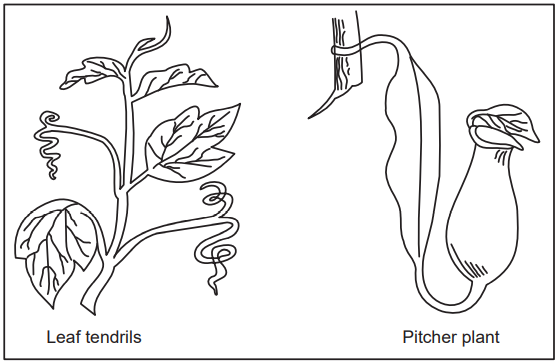
Make sure you also check our other amazing Article on : Morphology of Roots
